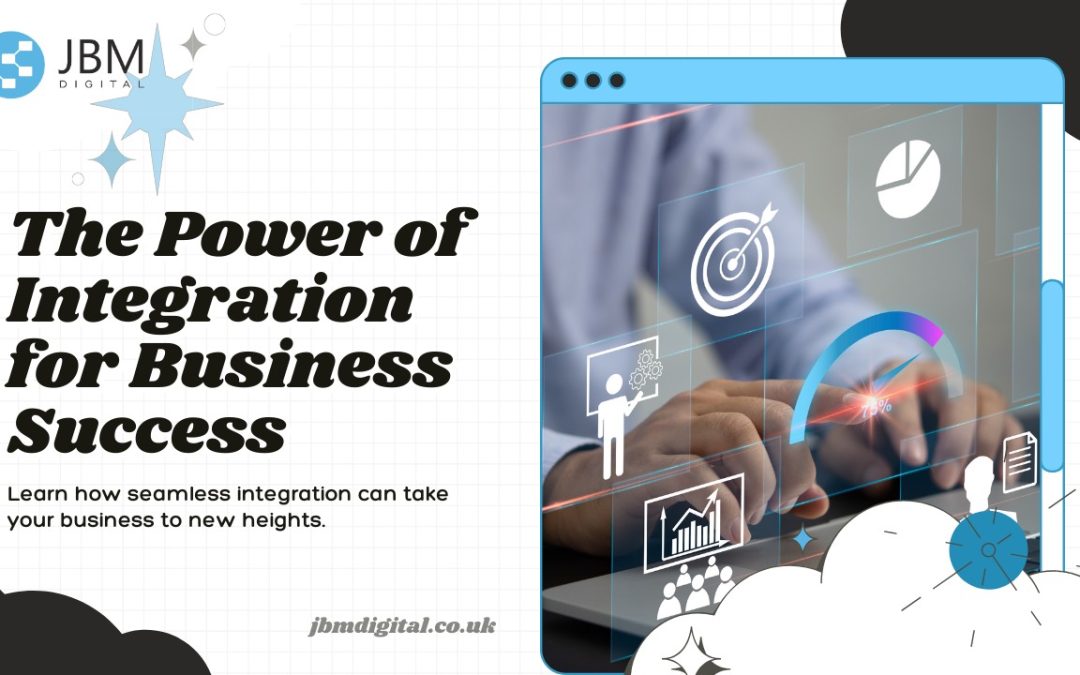
by JBM Digital | Feb 8, 2024 | Integration

Photo by gethroughusa on Pixabay
Introduction to Business Integration for Small and Medium Enterprises
Business integration plays a vital role in the success and growth of small and medium enterprises (SMEs). In today’s highly competitive market, SMEs need to streamline their operations, enhance productivity, and increase profitability to stay ahead. This guide will delve into the importance of business integration for SMEs, the benefits it offers, the common challenges faced, key steps to successful integration, strategies for maximizing productivity, tools, and technologies for implementation, case studies of successful integration, best practices for ensuring profitability, and finally, the future of business integration for SMEs.
Understanding the Importance of Business Integration
Business integration refers to the process of combining various departments, functions, and systems within an organization to create a unified and seamless operation. For SMEs, integration is crucial as it enables them to align their goals, streamline processes, and eliminate silos. By integrating different aspects of their business, SMEs can achieve a holistic view of their operations, which leads to better decision-making and improved overall performance. Integration also fosters collaboration among teams, enhances communication, and creates a more efficient and productive work environment.
Benefits of Business Integration for Small and Medium Enterprises
The benefits of business integration for SMEs are numerous and impactful. Firstly, integration leads to improved operational efficiency by reducing duplication of efforts and eliminating manual errors. By automating processes and centralizing data, SMEs can save time, and resources, and reduce costs. Integration also allows for better customer relationship management, as data from different departments can be consolidated to provide a comprehensive view of customer interactions. This enables SMEs to deliver personalized experiences, build stronger relationships, and ultimately, increase customer satisfaction and loyalty.
Additionally, business integration enhances scalability and agility. SMEs can quickly adapt to changing market conditions and seize new opportunities as they arise. Integration enables seamless data flow, which facilitates faster decision-making and response times. By leveraging integrated systems, SMEs can also gain valuable insights into their operations, enabling them to identify areas for improvement and make data-driven strategic decisions.
Common Challenges in Business Integration
While business integration offers numerous benefits, SMEs may face several challenges during the integration process. One common challenge is the resistance to change from employees. Integration often requires modifications to existing workflows and systems, which can be met with resistance. To overcome this challenge, clear communication and employee training are essential. It is crucial to involve employees in the integration process, address their concerns, and highlight the benefits that integration will bring to their work.
Another challenge is the complexity of integrating different systems and technologies. SMEs may have legacy systems that are not easily compatible with newer technologies. This can lead to delays, inefficiencies, and increased costs. To address this challenge, SMEs should invest in scalable and flexible integration solutions that can seamlessly connect various systems and applications. It is also important to work with experienced integration partners who can provide guidance and support throughout the process.
Key Steps to Successful Business Integration
To ensure successful business integration, SMEs should follow a systematic approach. The first step is to conduct a comprehensive assessment of the current state of the business. This involves identifying the areas that need integration, understanding the existing systems and processes, and determining the goals and objectives of integration.
The next step is to develop a detailed integration plan. This plan should outline the specific objectives, timelines, resources required, and potential risks. It should also include a communication strategy to keep all stakeholders informed and engaged throughout the process.
Once the plan is in place, SMEs can start implementing the integration. This involves configuring systems, migrating data, and testing the integrated processes. It is essential to conduct thorough testing to ensure that the integration is seamless and that all systems are functioning as intended.

After the integration is complete, SMEs should monitor and evaluate the effectiveness of the integrated systems. Regular performance reviews and feedback from employees and customers can help identify any issues or areas for improvement. It is also important to provide ongoing training and support to employees to ensure they fully understand and utilize the integrated systems.
Strategies for Maximizing Productivity Through Business Integration
Business integration can significantly enhance productivity for SMEs. By streamlining processes, eliminating redundant tasks, and automating workflows, SMEs can save time and resources, allowing employees to focus on more value-added activities. Here are some strategies to maximize productivity through business integration:
1. Standardization of Processes
Standardizing processes across different departments and functions can improve efficiency and reduce errors. By establishing clear guidelines and standard operating procedures, SMEs can ensure consistency and eliminate redundancies. This also facilitates cross-functional collaboration and enables employees to easily understand and follow processes.
2. Automation of Repetitive Tasks
Automation is a powerful tool for SMEs to increase productivity. By automating repetitive and manual tasks, such as data entry, report generation, and inventory management, SMEs can free up valuable time for employees to focus on more strategic and creative work. Automation also reduces the risk of errors and improves overall accuracy.
3. Integration of Communication and Collaboration Tools
Effective communication and collaboration are essential for productivity. By integrating communication and collaboration tools, such as project management software, instant messaging platforms, and video conferencing solutions, SMEs can enhance team collaboration and streamline communication channels. This enables employees to work together seamlessly, regardless of their location or time zone.
Implementing Business Integration Tools and Technologies
Implementing business integration requires the right tools and technologies. There are various options available, depending on the specific needs and requirements of SMEs. Here are some key tools and technologies that can facilitate business integration:
1. Enterprise Resource Planning (ERP) Systems
ERP systems provide a centralized platform for managing various aspects of the business, including finance, human resources, inventory, and customer relationship management. By integrating different modules within the ERP system, SMEs can achieve a unified view of their operations and streamline processes.
2. Application Programming Interfaces (APIs)
APIs allow different software applications to communicate with each other and share data. SMEs can leverage APIs to integrate their existing systems and applications, enabling seamless data flow and eliminating the need for manual data entry or duplication.
3. Cloud Computing
Cloud computing offers scalability, flexibility, and cost-efficiency for SMEs. By migrating their systems and data to the cloud, SMEs can access their applications and information from anywhere, at any time. Cloud-based solutions also provide easy integration capabilities, allowing SMEs to connect different systems and applications effortlessly.

Case Studies of Successful Business Integration in Small and Medium Enterprises
To understand the real-world impact of business integration, let’s examine some case studies of successful integration in SMEs:
1. Case Study: XYZ Company
XYZ Company, a small manufacturing business, implemented an ERP system to integrate its finance, inventory, and production processes. By centralizing data and automating workflows, they were able to improve inventory management, reduce lead times, and enhance overall operational efficiency. The integration also allowed them to gain better visibility into their financial performance, leading to more accurate forecasting and decision-making.
2. Case Study: ABC Consultancy
ABC Consultancy, a medium-sized professional services firm, integrated its customer relationship management (CRM) system with its project management software. This integration enabled seamless data flow between the two systems, providing a comprehensive view of client interactions and project status. As a result, they were able to improve client satisfaction, streamline project delivery, and increase overall productivity.
Best Practices for Ensuring Profitability through Business Integration
While business integration offers various benefits, ensuring profitability is crucial for SMEs. Here are some best practices to maximize profitability through business integration:
1. Continuously Monitor Key Performance Indicators (KPIs)
Monitoring KPIs is essential to measure the effectiveness of business integration. SMEs should identify the key metrics that align with their business goals and regularly track and analyze them. This allows for the timely identification of performance gaps and areas for improvement.
2. Foster a Culture of Innovation and Continuous Improvement
Business integration should not be a one-time activity but an ongoing process. SMEs should foster a culture of innovation and continuous improvement, encouraging employees to identify opportunities for optimization and efficiency gains. By embracing a growth mindset and encouraging experimentation, SMEs can stay ahead of the competition and drive profitability.
Conclusion: The Future of Business Integration for Small and Medium Enterprises
As SMEs strive for growth and success in an increasingly competitive landscape, business integration will continue to play a crucial role. By embracing integration, SMEs can streamline their operations, enhance productivity, and increase profitability. The future of business integration lies in leveraging emerging technologies, such as artificial intelligence and machine learning, to automate processes, gain valuable insights, and make data-driven decisions. SMEs that embrace business integration today will be well-positioned to thrive in the ever-evolving business landscape of tomorrow.
Implementing business integration can transform your SME. Contact us today to discuss how our integration solutions can help your business maximize productivity and profitability.

by JBM Digital | Feb 6, 2024 | Integration

Christian Morillo on Pexels
Introduction to Integration in UK Businesses
Integration has become a buzzword in the business world, and for good reason. It has proven to be a game-changer for businesses across the United Kingdom, enabling them to streamline processes, improve productivity, and ultimately achieve success. Integration, in the context of business, refers to the seamless connection of various systems and processes within an organization. This can include integrating software applications, databases, communication channels, and even departments or teams.
The integration of systems and processes has become particularly important in the digital age, where businesses are constantly seeking ways to operate more efficiently and stay ahead of the competition. By breaking down silos and fostering collaboration, integration allows businesses to achieve a level of efficiency that was previously unattainable. In this article, we will explore the importance of integration for business success in the UK and delve into how it improves efficiency.
The Importance of Integration for Business Success
In today’s fast-paced and interconnected business landscape, the ability to adapt and respond quickly to changing market conditions is crucial. Integration plays a pivotal role in enabling businesses to do just that. By connecting various systems and processes, businesses can achieve a unified view of their operations, making it easier to identify bottlenecks, optimize workflows, and make data-driven decisions.
One of the key benefits of integration is the elimination of manual and repetitive tasks. When systems and processes are integrated, information flows seamlessly between them, reducing the need for manual data entry and minimizing the risk of errors. This not only saves time but also improves accuracy, allowing businesses to operate more efficiently and effectively.

Moreover, integration enables businesses to break down information silos and foster collaboration across different departments or teams. By providing access to real-time data and insights, integration allows employees to make informed decisions and collaborate more effectively. This leads to increased productivity, better customer service, and ultimately, improved business performance.
How Integration Improves Efficiency in UK Businesses
Integration has the power to transform businesses by improving efficiency across the board. Let’s explore some of the key ways in which integration accomplishes this.
1. Streamlining Workflows
Integration allows businesses to streamline their workflows by automating repetitive tasks and ensuring smooth information flow between different systems and processes. For example, integrating a customer relationship management (CRM) system with an email marketing platform can automate the process of sending personalized emails to customers based on their purchase history or preferences. This not only saves time but also ensures a consistent and personalized customer experience.
2. Enhancing Data Accuracy and Accessibility
Integration eliminates the need for manual data entry and reduces the risk of errors that can occur when information is transferred between systems manually. By integrating systems, businesses can ensure that data is entered once and automatically updated across all relevant systems. This not only improves data accuracy but also enhances data accessibility, allowing employees to access real-time information whenever they need it.
3. Enabling Real-time Reporting and Analytics
Integration enables businesses to generate real-time reports and gain valuable insights into their operations. By connecting various systems and processes, businesses can have a unified view of their data, making it easier to identify trends, spot opportunities, and address issues promptly. Real-time reporting and analytics empower businesses to make data-driven decisions quickly, leading to improved efficiency and better business outcomes.
In the next section, we will explore some case studies of successful integration in UK businesses to illustrate the transformative power of integration.
Case Studies of Successful Integration in UK Businesses
Case Study 1: Company XYZ – Streamlining Supply Chain
Company XYZ, a leading logistics company in the UK, successfully implemented integration across its supply chain operations. By integrating its inventory management system with its order fulfillment system, Company XYZ was able to automate the process of tracking inventory levels and replenishing stock. This not only reduced manual effort but also ensured that products were always available when needed, improving customer satisfaction and streamlining the supply chain.
Case Study 2: Company ABC – Improving Customer Service
Company ABC, a UK-based e-commerce retailer, integrated its customer support system with its CRM system to improve customer service. By integrating these systems, customer service representatives had access to real-time customer data, purchase history, and previous interactions. This allowed them to provide personalized and efficient support, resulting in increased customer satisfaction and loyalty.
Case Study 3: Company DEF – Optimizing Financial Management
Company DEF, a financial services company in the UK, integrated its accounting system with its project management system to streamline financial management. By automating the process of tracking project expenses, invoicing, and financial reporting, Company DEF was able to reduce manual effort, improve accuracy, and gain real-time insights into project profitability. This integration enabled Company DEF to optimize its financial management processes and make data-driven decisions to improve profitability.
These case studies highlight the tangible benefits that integration can bring to UK businesses. However, implementing integration is not without its challenges and considerations. In the following section, we will explore some of the key challenges businesses may face when implementing integration and provide best practices for overcoming them.
Challenges and Considerations When Implementing Integration
While integration can bring numerous benefits to businesses, it is not without its challenges. Here are some of the key challenges businesses may face when implementing integration and how to address them:
1. Legacy Systems and Compatibility Issues
Many businesses in the UK still rely on legacy systems that may not be compatible with modern integration technologies. To overcome this challenge, it is important to assess the compatibility of existing systems and consider investing in middleware or integration platforms that can bridge the gap between legacy and modern systems.
2. Data Security and Privacy Concerns
Integration involves the sharing of data between different systems, which raises concerns about data security and privacy. To address these concerns, businesses should implement robust security measures, such as encryption and access controls, and comply with relevant data protection regulations, such as the General Data Protection Regulation (GDPR).
3. Resistance to Change and Organizational Culture
Implementing integration often requires changes in workflows and processes, which can be met with resistance from employees. To overcome this challenge, it is important to involve employees in the integration process from the beginning, provide training and support, and communicate the benefits of integration clearly.
In addition to addressing these challenges, there are several best practices that businesses can follow to ensure successful integration. Let’s explore some of these best practices in the next section.
Best Practices for Integrating Systems and Processes
To ensure successful integration, businesses should consider the following best practices:
1. Define Clear Objectives and Scope
Before embarking on an integration project, it is important to define clear objectives and scope. This involves identifying the specific systems and processes that need to be integrated and setting measurable goals for the integration project. Clear objectives and scope help keep the project focused and ensure that resources are allocated effectively.
2. Involve Stakeholders and Obtain Buy-in
Integration projects often involve multiple stakeholders, including IT teams, department heads, and end-users. It is important to involve these stakeholders from the beginning and obtain their buy-in. This helps ensure that the integration project aligns with the overall business strategy and addresses the specific needs of different stakeholders.
3. Conduct Thorough Testing and Training
Before deploying an integrated system or process, it is important to conduct thorough testing to identify and address any issues or bugs. This includes testing the integration of different systems, as well as testing user interfaces and workflows. Additionally, providing comprehensive training to end-users is crucial to ensure that they can effectively use the integrated systems and processes.
By following these best practices, businesses can increase the chances of successful integration and maximize the benefits it brings. However, implementing integration requires the right tools and technologies. In the next section, we will explore some of the key tools and technologies businesses can leverage for integration in the UK.
Tools and Technologies for Integration in UK Businesses
Integration requires the right tools and technologies to connect different systems and processes effectively. Here are some of the key tools and technologies that businesses in the UK can leverage for integration:
1. Integration Middleware
Integration middleware, also known as integration platforms, provide a central hub for connecting different systems and processes. These platforms often offer a range of pre-built connectors and adapters that simplify the integration process. Popular integration middleware solutions include MuleSoft, Dell Boomi, and Informatica.
2. Application Programming Interfaces (APIs)
APIs allow different software applications to communicate with each other, enabling seamless integration. Businesses can leverage APIs provided by software vendors or develop their own APIs to connect systems and processes. APIs have become increasingly popular in the era of cloud computing and software-as-a-service (SaaS) solutions.
3. Robotic Process Automation (RPA)
Robotic Process Automation (RPA) involves using software robots or “bots” to automate repetitive tasks. RPA can be leveraged for integration by automating the transfer of data between different systems or automating manual data entry. RPA tools such as UiPath, Automation Anywhere, and Blue Prism are widely used for integration purposes.
These are just a few examples of the tools and technologies available for integration in UK businesses. The choice of tools and technologies will depend on the specific needs and requirements of each business.
The Future of Integration in UK Businesses
Integration is expected to play an increasingly important role in the future of UK businesses. As technology continues to advance and businesses become more digitally-driven, the need for seamless connectivity and collaboration will only grow. The rise of cloud computing, artificial intelligence, and the Internet of Things (IoT) will further fuel the demand for integration, as businesses seek to leverage the full potential of these technologies.
Moreover, as businesses become more global and interconnected, the need for integration across borders and between different organizations will become more prevalent. Integration will play a vital role in enabling businesses to collaborate with partners, suppliers, and customers across the globe, facilitating seamless communication and information sharing.
Integration Services and Solutions for UK Businesses
Given the increasing importance of integration in the business landscape, there are numerous integration services and solutions available to UK businesses. These range from consulting services that help businesses design and implement integration strategies to managed services that provide ongoing support and maintenance for integrated systems.
When choosing an integration service or solution, it is important to consider factors such as the specific integration needs of the business, the scalability and flexibility of the solution, and the track record and expertise of the service provider. Businesses should also consider factors such as cost, security, and compliance when evaluating integration services and solutions.
Conclusion: The Transformative Power of Integration in UK Businesses
Integration has proven to be a transformative force for businesses in the United Kingdom. By connecting systems and processes, integration enables businesses to operate more efficiently, streamline workflows, and make data-driven decisions. It eliminates manual and repetitive tasks, enhances data accuracy and accessibility, and enables real-time reporting and analytics.
While implementing integration can come with challenges, businesses can overcome them by following best practices and leveraging the right tools and technologies. As integration continues to evolve and become increasingly important, businesses in the UK should embrace it as a strategic imperative for success.
To unlock efficiency and stay ahead of the competition, UK businesses must harness the power of integration. By breaking down silos, fostering collaboration, and leveraging the right integration services and solutions, businesses can unlock their full potential and achieve sustainable success in today’s fast-paced and interconnected business landscape.
Contact us today to take your business to the next level.

by JBM Digital | Jan 25, 2024 | Integration

KJ Brix from Pexels
Introduction to artificial intelligence in business process optimization
Artificial intelligence (AI) has revolutionized the way businesses operate and has become an integral part of modern-day business process optimization. AI refers to the simulation of human intelligence in machines that are programmed to think and learn like humans. In the context of business process optimization, AI technologies are used to automate and streamline various tasks, leading to increased efficiency, reduced costs, and improved decision-making.
AI in business process optimization has gained significant attention due to its ability to analyze large volumes of data, identify patterns, and make intelligent recommendations. This technology has the potential to transform the way organizations operate by automating repetitive tasks, enhancing customer experiences, and enabling data-driven decision-making. In this article, we will explore the benefits of using AI in business process optimization, provide examples of its applications, and discuss current trends and statistics in AI adoption.
Benefits of using artificial intelligence in business process optimization
The use of AI in business process optimization offers numerous benefits to organizations across various industries. One of the primary advantages is increased efficiency. AI-powered systems can analyze vast amounts of data and perform tasks at a speed and accuracy that surpasses human capabilities. This enables businesses to streamline their operations, reduce errors, and improve overall productivity.
Additionally, AI can enhance decision-making by providing valuable insights based on data analysis. By leveraging machine learning algorithms, AI systems can identify trends, predict outcomes, and offer recommendations. This empowers organizations to make informed decisions and devise effective strategies to optimize their business processes.
Furthermore, AI can automate repetitive tasks, freeing up human resources to focus on more complex and strategic activities. This not only improves employee satisfaction but also enables organizations to allocate their workforce more efficiently. By automating mundane tasks, businesses can save time and reduce costs, leading to increased profitability.
Examples of artificial intelligence in business process optimization
AI can be applied to various areas of business process optimization, resulting in tangible benefits. One such example is customer service automation. Many organizations have implemented AI chatbots that can interact with customers, answer their queries, and provide relevant information. These chatbots use natural language processing and machine learning algorithms to understand customer needs and deliver personalized responses, thereby improving customer satisfaction and reducing the workload on human agents.
Another area where AI is making a significant impact is in supply chain management. By utilizing AI algorithms, businesses can optimize inventory levels, predict demand fluctuations, and improve logistics planning. This helps in reducing costs, minimizing stock outs, and increasing overall operational efficiency.
AI is also transforming the field of finance through automated data analysis and fraud detection. AI algorithms can analyze financial data in real-time, identify unusual patterns, and flag potential fraudulent activities. This not only helps in preventing financial losses but also ensures compliance with regulatory requirements.
Current trends and statistics in artificial intelligence adoption
The adoption of AI in business process optimization is rapidly increasing across the globe. According to a report by PwC, AI is expected to contribute over $15 trillion to the global economy by 2030. In the UK, the implementation of AI technologies in various sectors is gaining momentum. A study by Accenture estimates that AI could add £654 billion ($836 billion) to the UK economy by 2035.
The COVID-19 pandemic has further accelerated the adoption of AI as businesses strive to adapt to the changing landscape. Organizations are increasingly relying on AI-powered solutions to automate processes, enhance remote collaboration, and ensure business continuity.
In terms of industry-specific adoption, healthcare, finance, and manufacturing are leading the way. Healthcare organizations are utilizing AI for medical image analysis, drug discovery, and telehealth services. Financial institutions are leveraging AI for risk assessment, fraud detection, and personalized financial advice. The manufacturing sector is incorporating AI to optimize production processes, improve quality control, and enable predictive maintenance.
How artificial intelligence can automate business processes
AI has the potential to automate various business processes, enabling organizations to achieve higher levels of efficiency and productivity. One of the key ways AI can automate processes is through robotic process automation (RPA). RPA involves the use of software robots or “bots” that can mimic human actions and perform repetitive tasks. These bots can retrieve and process data, generate reports, and even interact with other systems.
By implementing RPA, businesses can automate tasks such as data entry, invoice processing, and order fulfillment. This not only reduces manual errors but also saves time and resources. Additionally, RPA can be integrated with AI technologies to enhance its capabilities. For example, AI-powered bots can analyze data, make intelligent decisions, and adapt to changing scenarios.
Another way AI can automate business processes is through the use of machine learning algorithms. Machine learning algorithms can be trained on historical data to recognize patterns and make predictions. This can be particularly useful in areas such as demand forecasting, customer segmentation, and predictive maintenance. By automating these processes, organizations can optimize resource allocation, improve customer satisfaction, and minimize downtime.
Implementing artificial intelligence in the UK business sector
The UK business sector is actively embracing AI technologies to optimize their operations and gain a competitive edge. Various initiatives and investments have been made to foster AI adoption across different industries. The UK government has launched the AI Sector Deal, which aims to make the UK a global leader in AI. The deal includes funding for research and development, support for AI startups, and the establishment of AI research centers.
To implement AI successfully, businesses in the UK need to develop a clear AI strategy aligned with their overall business goals. They should identify the areas where AI can bring the most value and prioritize their implementation efforts accordingly. It is crucial to have the right talent and resources in place to ensure the successful deployment and utilization of AI technologies.
Moreover, businesses should consider the ethical implications of AI adoption. They should ensure that AI systems are transparent, explainable, and unbiased. Data privacy and security should also be a top priority when implementing AI in business processes. Compliance with relevant regulations, such as the General Data Protection Regulation (GDPR), is essential to maintain trust and protect sensitive information.
Challenges and considerations in adopting artificial intelligence for business process optimization
While the benefits of adopting AI for business process optimization are substantial, there are also challenges and considerations that organizations need to address. One of the primary challenges is the lack of understanding and knowledge about AI technologies. Many businesses are unsure about how to leverage AI effectively and may struggle with the implementation process. Addressing this challenge requires investing in AI education and training programs to upskill employees and build AI capabilities within the organization.
Another consideration is the potential impact on the workforce. The automation of certain tasks through AI technologies may lead to job displacement. However, it is important to note that AI also creates new job opportunities, particularly in areas such as AI development, data analysis, and AI strategy. Organizations should focus on reskilling and retraining their employees to ensure a smooth transition and to capitalize on the benefits of AI.
Ethical concerns surrounding AI adoption should also be taken into account. AI technologies have the potential to amplify biases and discrimination if not properly designed and monitored. It is crucial to establish ethical frameworks and guidelines to ensure fairness, transparency, and accountability in AI-driven decision-making.
Best practices for integrating artificial intelligence into business processes
To successfully integrate AI into business processes, organizations should follow some best practices. Firstly, it is important to start small and focus on specific use cases that offer the most immediate value. By piloting AI projects in a controlled environment, businesses can learn from the experience and fine-tune their approach.

Secondly, having a strong data infrastructure is essential. AI relies heavily on data, and organizations should ensure that they have access to high-quality and relevant data. Data governance practices should be implemented to maintain data integrity, security, and compliance.
Thirdly, collaboration between data scientists, domain experts, and business leaders is crucial. By bringing together diverse perspectives, organizations can better identify AI opportunities, define objectives, and develop AI models that align with business needs.
Finally, continuous monitoring and evaluation of AI models and algorithms is essential. AI technologies are not static and require ongoing refinement and improvement. Regular monitoring helps in identifying biases, addressing performance issues, and ensuring that AI systems remain aligned with organizational goals.
AI tools and technologies for business process optimization
There are several AI tools and technologies available that organizations can leverage for business process optimization.
- Natural language processing (NLP) allows machines to understand and interpret human language, enabling applications such as chatbots and voice assistants.
- Machine learning algorithms enable machines to learn from data and make predictions, facilitating tasks such as demand forecasting and customer segmentation.
- Computer vision technologies enable machines to analyze and interpret visual data, enabling applications such as image recognition and object detection.
- Robotic process automation (RPA) involves the use of software robots to automate repetitive tasks, while cognitive automation combines AI and RPA to automate complex tasks that involve cognitive capabilities.
Furthermore, AI-powered analytics platforms provide organizations with the ability to analyze large volumes of data, uncover insights, and make data-driven decisions. These platforms utilize AI algorithms to process structured and unstructured data, identify patterns, and generate actionable insights.
Conclusion: The future of artificial intelligence in business process optimization
Artificial intelligence has emerged as a powerful tool for business process optimization, offering numerous benefits to organizations across various industries. Its ability to automate tasks, enhance decision-making, and improve efficiency has made it a critical component of modern-day business operations.
The adoption of AI is expected to continue to grow, driven by advancements in technology, increasing data availability, and changing business needs. Organizations in the UK and beyond need to embrace AI and develop strategies to effectively leverage its potential. By incorporating AI into their business processes, organizations can gain a competitive edge, increase productivity, and achieve sustainable growth.
As AI technologies continue to evolve, it is important to address ethical considerations, ensure transparency and accountability, and prioritize the well-being of employees and customers. With the right approach, AI has the potential to revolutionize business process optimization and shape the future of work.
Contact us today for your business process optimization

by JBM Digital | Jan 15, 2024 | Integration
Unlocking Efficiency: Best System Integration Practices for UK Businesses.

Photo by fauxels from Pexels
As businesses in the UK continue to grow and evolve, the need for efficient and streamlined processes becomes increasingly important. One way to achieve this is through system integration. System integration is the process of connecting different software applications and systems within an organization to ensure seamless communication and data flow.
In this article, we will explore why system integration matters, the challenges businesses face when implementing it, the key benefits of an effective system integration strategy, and how to choose and implement the right integration plan.
System integration plays a crucial role in enhancing productivity and efficiency within an organization. By integrating various systems and applications, businesses can eliminate manual data entry, reduce errors, and improve overall workflow. A well-integrated system allows for real-time data sharing, which enables faster decision-making and better collaboration among teams. Additionally, system integration enhances customer experience by providing a unified view of customer data, enabling personalized interactions and smoother transactions.
Challenges of system integration
While the benefits of system integration are undeniable, businesses often encounter challenges when implementing it.
- One common challenge is the complexity of integrating different systems that may have been developed at different times and using different technologies. This can lead to compatibility issues and require significant effort to ensure seamless integration.
- Additionally, data security and privacy concerns arise when integrating systems that handle sensitive information. It is essential to have robust security measures in place to protect data from unauthorized access or breaches.
- Another challenge is the resistance to change from employees who are accustomed to working with existing systems. Training and change management efforts are crucial to ensure the successful adoption of the new integrated system.
- Finally, budget and resource constraints can pose challenges when implementing system integration. It is essential to carefully plan and allocate resources to avoid cost overruns and delays.
Key Benefits of an Effective System Integration
Implementing an effective system integration strategy offers numerous benefits to UK businesses. Firstly, it improves efficiency by automating processes and reducing manual data entry. This frees up employees’ time, allowing them to focus on more value-added tasks.

Photo by Christina Morillo from Pexels:
Secondly, system integration enhances data accuracy by eliminating errors that can occur during manual data transfer. With real-time data synchronization, businesses can make informed decisions based on reliable and up-to-date information.
Thirdly, system integration enables better collaboration among teams. With integrated systems, different departments can access and share data seamlessly, leading to improved communication and coordination. This promotes a more cohesive and productive work environment. Additionally, system integration enhances customer satisfaction by providing a unified view of customer data. This enables businesses to deliver personalized experiences and tailored solutions, resulting in increased customer loyalty.
Choosing the Right Integration Strategy
Selecting the appropriate integration strategy is crucial for successful implementation. The choice will depend on factors such as the complexity of existing systems, business requirements, and available resources.
- One common integration strategy is point-to-point integration, where systems are directly connected to exchange data. This approach is suitable for simple integrations but can become complex and challenging to maintain as the number of systems increases.
- Another strategy is the use of middleware or integration platforms that act as a central hub, connecting multiple systems. This approach provides flexibility and scalability, allowing businesses to add or remove systems easily. It also enables data transformation and orchestration, simplifying the integration process.
Cloud-based integration platforms offer additional benefits such as cost-effectiveness and easy access to data from anywhere.
Implementing a System Integration Plan
To successfully implement a system integration plan, several key steps must be followed.
- Firstly, it is essential to conduct a thorough assessment of existing systems and business requirements. This analysis will help identify integration needs, potential challenges, and desired outcomes. Based on this assessment, a detailed integration plan should be developed, outlining the integration strategy, timeline, and resource allocation.
- Next, it is crucial to ensure data security and privacy by implementing robust security measures. This includes encrypting sensitive data, implementing access controls, and regularly monitoring and auditing system activities.
- Adequate training and change management efforts should also be planned to facilitate the smooth adoption of the integrated system. Employees should be provided with the necessary knowledge and support to navigate and utilize the new system effectively.
- Regular monitoring and testing of the integrated system are vital to identify and resolve any issues or performance bottlenecks. This includes conducting regular data integrity checks, performance testing, and user acceptance testing.
Ongoing maintenance and updates should be performed to ensure the system remains secure and optimized.
Conclusion
System integration is a powerful tool for unlocking efficiency and streamlining business processes in the UK. By connecting different systems and applications, businesses can achieve real-time data sharing, automate processes, and improve overall productivity. While challenges may arise during implementation, careful planning, robust security measures, and effective change management can ensure a successful integration. By choosing the right integration strategy and following a well-defined plan, businesses can reap the numerous benefits of system integration and stay ahead in the competitive UK market.
CTA: Contact us today @Jbm Digital to learn more about how system integration can transform your business and unlock new levels of efficiency.

by JBM Digital | Jan 8, 2024 | Integration

Image Source: Unsplash
Introduction to Integration in the Business World
Integration has become a fundamental aspect of success in today’s business landscape. In a world that is becoming increasingly connected, businesses must adapt and find ways to leverage the power of integration to thrive. Integration is the process of combining different aspects of a business, such as departments, technologies, and systems, to create a seamless and efficient operation. It allows businesses to break down silos, streamline processes, and improve overall performance. In this article, we will explore the benefits of integration, real-life examples of successful integration, key strategies for implementation, challenges to overcome, the role of technology, the impact on customer experience, and how to measure success. By embracing integration, businesses can position themselves for future success in the UK and beyond.
Benefits of Integrating Different Aspects of a Business
When businesses integrate different aspects of their operations, they unlock a range of benefits. Firstly, integration improves efficiency by eliminating duplicate or unnecessary processes. By streamlining operations, businesses can reduce costs, save time, and improve productivity. For example, a retail store that integrates its inventory management system with its point-of-sale system can automate inventory updates, reduce manual errors, and improve stock management.
Integration also enables better communication and collaboration among different departments. When information flows seamlessly between teams, decision-making becomes faster and more informed. For instance, a manufacturing company that integrates its production and sales departments can ensure that production aligns with customer demand, leading to optimized inventory levels and increased customer satisfaction.
Furthermore, integration allows businesses to gain a holistic view of their operations. By integrating data from various sources, such as sales, marketing, and customer service, businesses can analyze trends, identify opportunities, and make data-driven decisions. This holistic view enables businesses to be more agile and responsive to market changes, giving them a competitive edge.
Real-Life Examples of Successful Business Integration
Several businesses have successfully implemented integration strategies to drive their growth and success. One notable example is Amazon. Through its integration of various services and departments, Amazon has created a seamless customer experience. From browsing products to making purchases and receiving timely deliveries, Amazon has integrated its entire supply chain to provide a frictionless shopping experience.
Another example is Tesla, the electric car manufacturer. Tesla has integrated its manufacturing, software, and energy storage systems, allowing for efficient production, remote software updates, and innovative energy solutions. This integration has enabled Tesla to disrupt the automotive industry and become a market leader in electric vehicles.
These examples highlight how integration can transform businesses and industries, setting them apart from their competitors and driving growth.
Key Strategies for Implementing Integration Within a Business
Implementing integration within a business requires careful planning and execution. Here are some key strategies to consider:
- Define clear objectives: Before embarking on integration, businesses must clearly define their objectives and what they aim to achieve. Whether it’s improving efficiency, enhancing customer experience, or driving innovation, having clear objectives will guide the integration process.
- Identify integration opportunities: Businesses should assess their operations and identify areas where integration can bring the most value. This could involve integrating systems, processes, or departments that currently operate in isolation.
- Engage stakeholders: Successful integration requires buy-in and involvement from all stakeholders. Engage employees, department heads, and key decision-makers to ensure alignment and support throughout the process.
- Develop an integration plan: Create a detailed plan that outlines the steps, timelines, and resources required for integration. This plan should address potential challenges and include contingency measures.
- Invest in technology: Technology plays a vital role in integration. Businesses should invest in tools and systems that enable seamless data sharing, process automation, and cross-functional collaboration.
- Train and educate employees: Integration often involves changes in processes and workflows. Provide training and education to employees to ensure they understand the benefits of integration and how to navigate the new integrated landscape.
By following these strategies, businesses can successfully implement integration and reap its benefits.
Overcoming Challenges in the Integration Process
Implementing integration within a business is not without its challenges. Some common challenges include resistance to change, lack of integration expertise, and technological barriers. To overcome these challenges, businesses can take the following steps:
- Communicate the benefits: Address resistance to change by clearly communicating the benefits of integration to all stakeholders. Highlight how integration will improve efficiency, collaboration, and overall business performance.
- Seek external expertise: If the business lacks integration expertise, consider partnering with external consultants or experts who can provide guidance and support throughout the integration process.
- Invest in training and development: Provide training and development opportunities to employees to build the necessary skills and knowledge required for integration. This could include workshops, online courses, or mentorship programs.
- Conduct thorough technology assessments: Identify any technological barriers that could hinder integration. Assess existing systems and determine if upgrades or new technology investments are necessary for seamless integration.
- Establish clear communication channels: Effective communication is crucial during the integration process. Establish clear channels for feedback, questions, and updates to ensure transparency and address any concerns or challenges promptly.
By proactively addressing these challenges, businesses can navigate the integration process more smoothly and minimize disruptions.
The Role of Technology in Achieving Business Integration
Technology plays a pivotal role in achieving seamless business integration. Here are some ways in which technology enables and supports integration:
- Data integration: Technology allows businesses to integrate data from various sources, such as customer relationship management (CRM) systems, sales platforms, and marketing analytics tools. This integration provides a comprehensive view of the business and enables data-driven decision-making.
- System integration: Technology facilitates the integration of different systems within a business, such as enterprise resource planning (ERP), customer support, and inventory management systems. By integrating these systems, businesses can automate processes, reduce manual errors, and improve overall efficiency.
- Cloud computing: Cloud computing enables businesses to store and access data and applications remotely. This flexibility allows for seamless integration across different locations and departments, promoting collaboration and information-sharing.
- Application programming interfaces (APIs): APIs enable different software applications to communicate and share data with each other. By leveraging APIs, businesses can integrate their systems and processes, creating a unified and connected environment.
- Collaboration tools: Technology provides collaboration tools, such as project management platforms, communication apps, and virtual meeting software. These tools facilitate cross-functional collaboration, enabling teams to work together regardless of geographical location.
By leveraging technology, businesses can overcome barriers to integration and create a connected and efficient operation.
The Impact of Integration on Customer Experience and Satisfaction
Integration has a significant impact on customer experience and satisfaction. When businesses integrate their various touchpoints, such as online platforms, mobile apps, and physical stores, they create a seamless and consistent customer journey. This consistency enhances the overall customer experience and increases customer satisfaction.
For example, a retail business that integrates its e-commerce platform with its brick-and-mortar stores can offer customers the option to browse and purchase products online, with the added convenience of in-store pickup or returns. This integration provides customers with a seamless experience and the flexibility to choose how they interact with the business.
Furthermore, integration allows businesses to personalize their interactions with customers. By integrating customer data from different sources, businesses can gain insights into customer preferences, purchase history, and behavior. This information enables businesses to tailor their offerings, promotions, and communications to individual customers, creating a personalized and meaningful experience.
By prioritizing integration and focusing on improving the customer experience, businesses can cultivate customer loyalty, increase repeat purchases, and ultimately drive business growth.
Measuring the Success of Business Integration
To measure the success of business integration, businesses should establish relevant metrics and track progress over time. Here are some key metrics to consider:
- Efficiency metrics: Measure the efficiency gains achieved through integration, such as cost savings, time reduction, and productivity improvements. This could include metrics like process cycle time, cost per transaction, or employee productivity ratios.
- Customer metrics: Track customer satisfaction, loyalty, and retention rates to assess the impact of integration on the customer experience. This could involve conducting customer surveys, analyzing customer feedback, or monitoring repeat purchase rates.
- Revenue metrics: Measure the impact of integration on revenue generation, such as increased sales, average transaction value, or customer lifetime value. Compare revenue performance before and after integration to assess its impact on the business’s financial health.
- Data quality metrics: Evaluate the quality and accuracy of integrated data to ensure the integrity of decision-making. This could involve assessing data completeness, consistency, and timeliness.
- Employee metrics: Assess employee satisfaction, engagement, and productivity to gauge the impact of integration on the workforce. This could include conducting employee surveys, tracking turnover rates, or monitoring key performance indicators.
By regularly monitoring these metrics, businesses can gauge the success of their integration efforts and make informed adjustments if necessary.
Case Studies of Businesses That Have Thrived Through Integration
To further illustrate the power of integration, let’s explore two case studies of businesses that have successfully leveraged integration to thrive:
Starbucks, the global coffee chain, has embraced integration to create a seamless and personalized customer experience. By integrating its mobile app, loyalty program, and in-store operations, Starbucks has revolutionized the way customers order and pay for their beverages. Customers can use the mobile app to order ahead, earn rewards, and pay for their purchases, all while enjoying a personalized experience tailored to their preferences. This integration has not only improved efficiency but also increased customer satisfaction and loyalty.
Case Study 2: Airbnb
Airbnb, the online marketplace for short-term rentals, has transformed the travel industry through integration. By integrating its platform with various partner services, such as transportation, local experiences, and restaurant reservations, Airbnb offers a complete travel ecosystem to its users. This integration allows travelers to seamlessly book accommodations, plan activities, and explore local recommendations, all in one place. By providing a comprehensive and integrated travel experience, Airbnb has disrupted the industry and gained a competitive edge.
These case studies demonstrate how integration can drive innovation, enhance customer experience, and set businesses apart from their competitors.
Conclusion: Embracing the Power of Integration for Future Business Success
In today’s connected world, integration has become a necessity for businesses to thrive. By integrating different aspects of their operations, businesses can improve efficiency, enhance collaboration, gain a holistic view of their operations, and transform the customer experience. However, integration is not without its challenges, and businesses must carefully plan and execute their integration strategies. By leveraging technology, embracing change, and measuring success through relevant metrics, businesses can position themselves for future success in the UK and beyond. Integration is not just a buzzword; it is a powerful tool that businesses should embrace to unlock their full potential.
CTA: Ready to take your business to the next level? Explore the power of integration and how it can transform your operations. Contact us today for a consultation on how integration can drive your business success.
















Recent Comments